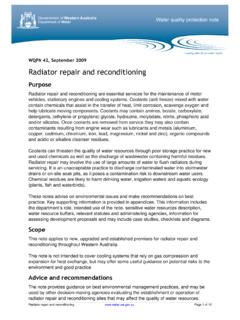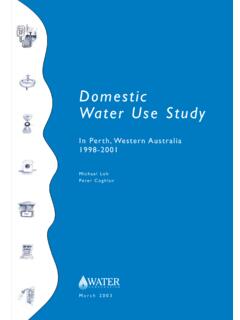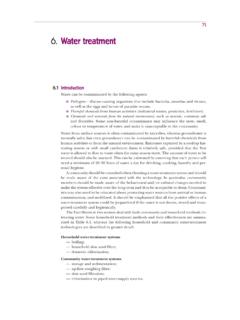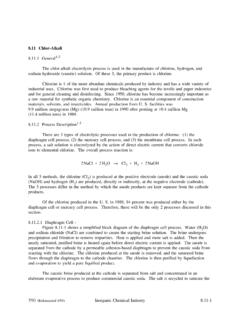Transcription of Wastewater treatment and disposal - domestic systems
1 Department of Water Page 1 Water quality protection note no. 70 March 2016 (interim update) Wastewater treatment and disposal - domestic systems Important information as at March 2016 The Department of Planning is currently revising and consolidating the Government sewerage policy Perth metropolitan region (1996) and the Draft country sewerage policy (2003). This water quality protection note (WQPN) will be reviewed and updated when the new policy is released. This WQPN provides updated advice for on-site Wastewater treatment and sewage disposal systems servicing a single dwelling or non-residential development that is located in a public drinking water source area (PDWSA) or near other sensitive water resources.
2 If you require additional information, please contact the Department of Water on +61 8 6364 7600 or Background domestic Wastewater is derived from bathrooms, kitchens, laundries and toilets. It includes human waste (containing pathogens), paper, soap, detergent residues and food scraps suspended in around 150 litres of Wastewater daily for each person in a household. The Government sewerage policy Perth metropolitan region (1996) and the Draft country sewerage policy (2003) (references 4e and 4f) were prepared to guide sewage management services. They define the minimum acceptable development density and lot size and water resource buffers for subdivision or development without a reticulated sewerage scheme connection.
3 Where properties cannot be connected to a reticulated sewer scheme, domestic Wastewater is normally treated and disposed of on-site. This Wastewater (commonly termed sewage effluent) may pose a contamination risk to water resources when discharged. Depending on the type of treatment , sewage effluent may still contain: pathogens, which can include disease-causing organisms ( bacteria, viruses, intestinal worms and protozoa) degradable organic matter that depletes dissolved oxygen in water and can cause foul odours suspended solids and sediment household chemical residues such as cleansers and disinfectants WQPN no.
4 70: Wastewater treatment and disposal domestic systems Department of Water Page 2 nutrients such as nitrogen and phosphorus, that foster algae blooms in waterways and wetlands detergent residues (which can harm aquatic plants and animals) trace metals and organics from plumbing fittings any substance flushed into the waste management system. Wastewater treatment is normally designed to remove gross solids, stabilise degradable organic material and settle out other solids as sludge. Because of the presence of pathogens, disinfection is required if the effluent discharge could contact food crops, people or water supplies.
5 Some treatment systems are also designed to reduce phosphorous levels (reference 4). Phosphorous-removing systems may be needed where local soils are poor at absorbing phosphorous and where runoff or groundwater may move this nutrient into a surface water body at risk of algae blooms. In some locations, natural soils (such as loam) are rich in iron and aluminium oxides and have an ability to bind phosphorous, so phosphorous-removing systems are generally not necessary. Currently, there are no effective domestic Wastewater treatment systems approved as nitrogen-removing systems in WA. Excessive nitrate-nitrogen poses a health risk to drinking water sources and contributes to algal blooms in surface waters.
6 The Department of Water is responsible for managing and protecting the state s water resources. It is also a lead agency for water conservation and reuse. This note offers: our current views on domestic Wastewater management in PDWSAs and near other sensitive water resources guidance on acceptable practices used to protect the quality of Western Australian water resources a basis for the development of a multi-agency code or guideline designed to balance the views of industry, government and the community, while sustaining a healthy environment. The note has been produced to inform landowners, government officers, environmental consultants and community members of our views on domestic Wastewater treatment and disposal ; from initial planning, through construction, operation and replacement with a reticulated sewer connection.
7 Scope This note applies only to on-site Wastewater treatment and effluent disposal systems servicing up to ten people in a single dwelling or workplace and located near sensitive water resources (see Water quality protection note no. 4 Sensitive water resources, reference 6a). This note provides advice in separate sections on conventional septic tank systems and alternative Wastewater treatment and disposal systems . The most common types of domestic Wastewater treatment systems used in Western Australia are described and recommendations are provided for their location and maintenance. Detailed information about the design, function, maintenance and WQPN no.
8 70: Wastewater treatment and disposal domestic systems Department of Water Page 3 operation of the systems may be obtained from the environmental health section of local governments, equipment suppliers or the Department of Health s Wastewater management branch (reference 4). All Wastewater systems for sale must be approved by the Department of Health (WA). The note is not intended to cover Wastewater facilities servicing connected groups of dwellings, such as mining camps, holiday resorts, remote communities, or municipal and industrial Wastewater treatment from reticulated sewerage schemes. Standard information to be read in conjunction with this note can be found in WQPN no.
9 3: Using water quality protection notes. Conventional domestic Wastewater treatment and effluent disposal systems These systems generally consist of watertight cylindrical tanks (septic tanks) followed by one or two sets of effluent soakage wells that have holes in their sides and no base (soakwells) or horizontal leach drains (Figure 1). Septic tank systems treat domestic Wastewater by sedimentation and anaerobic decomposition of sludge. This reduces the degradable organic content (measured as biochemical oxygen demand), suspended solids and grease levels prior to the effluent entering the surrounding soil. Septic tank systems do not significantly reduce micro-organisms or nutrient concentrations; however these may be reduced by movement through the natural soil.
10 Contaminant reduction depends on the soil s properties; travel time and the local environmental conditions surrounding the leach drain or soakwell. For more information, see the Department of Health s Environmental health information sheet Understanding septic tank systems (reference 4a). Figure 1: Conventional domestic septic tank and effluent disposal systems Cover Inlet pipe Drainage slots Concrete soak well diagram Side view of a leach drain 2m WQPN no. 70: Wastewater treatment and disposal domestic systems Department of Water Page 4 Alternative Wastewater treatment and effluent disposal systems Alternative systems that have received the approval of the Department of Health (WA) in addition to septic tank and subsoil effluent drainage systems include: Aerobic treatment units (ATUs) use the activated sludge process or fixed biological film filtration , followed by irrigation or subsoil disposal (Figure 2).









